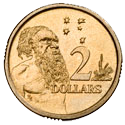
The Australian dollar is the currency of Australia, including its external territories: Christmas Island, Cocos (Keeling) Islands, and Norfolk Island. It is officially used as currency by three independent Pacific Island states: Kiribati, Nauru, and Tuvalu. It is legal tender in Australia. Within Australia, it is almost always abbreviated with the dollar sign ($), with A$ or AU$ sometimes used to distinguish it from other dollar-denominated currencies. The $ symbol precedes the amount. It is subdivided into 100 cents.

The quarter, short for quarter dollar, is a Canadian coin worth 25 cents or one-fourth of a Canadian dollar. It is a small, circular coin of silver colour. According to the Royal Canadian Mint, the official name for the coin is the 25-cent piece, but in practice it is usually called a "quarter", much like its American counterpart. In French, it is called a caribou or trente sous. The coin is produced at the Royal Canadian Mint's facility in Winnipeg, Manitoba.

The Cook Islands dollar is the currency of the Cook Islands. The dollar is subdivided into 100 cents, although some 50-cent coins carry the denomination as "50 tene".

The twelve-sided Australian fifty-cent coin is the third-highest denomination coin of the Australian dollar and the largest in terms of size in circulation. It is the only 12-sided coin of its size in the southern hemisphere. It was introduced in 1969 to replace the round fifty-cent coin issued in 1966.
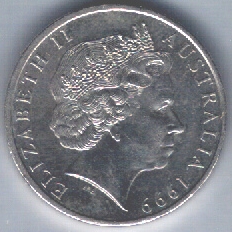
The Australian twenty-cent coin of the Australian decimal currency system was issued with conversion to decimal currency on 14 February 1966, replacing the florin which was worth two shillings – a tenth of a pound.
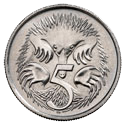
The Australian five-cent coin is the lowest-denomination circulating coin of the decimal Australian dollar introduced in 14 February 1966, replacing the pre-decimal sixpence. It has been the lowest-denomination coin in general circulation since the withdrawal of the one-cent and two-cent coins in 1992.
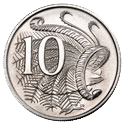
The Australian ten-cent coin is a coin of the decimal Australian dollar. When the dollar was introduced as half of an Australian pound on 14 February 1966, the coin inherited the specifications of the pre-decimal shilling; both coins were worth one twentieth of a pound. On introduction it was the fourth-lowest denomination coin. Since the withdrawal from circulation of the one and two cent coins in 1992, it has been the second-lowest denomination coin in circulation.
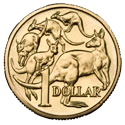
The Australian one dollar coin is the second-most-valuable circulation denomination coin of the Australian dollar after the two-dollar coin; there are also non-circulating legal-tender coins of higher denominations.
The coins of Canada are produced by the Royal Canadian Mint and denominated in Canadian dollars ($) and the subunit of dollars, cents (¢). An effigy of the reigning monarch always appears on the obverse of all coins. There are standard images which appear on the reverse, but there are also commemorative and numismatic issues with different images on the reverse.
The Australian fifty-dollar note is an Australian banknote with a face value of fifty Australian dollars (A$50). It is currently a polymer banknote, featuring portraits of David Unaipon and Edith Cowan.
The Australian twenty-dollar note was issued when the currency was changed from the Australian pound to the Australian dollar on 14 February 1966. It replaced the £10 note which had similar orange colouration. There have been only two different issues of this denomination: a paper note which had a gradient of yellow and red, with a distinct orange background, and a polymer note which can be recognised for its distinct red-orange colouration. The polymer note was issued on 31 October 1994 and the Next Generation banknote was issued on 9 October 2019.

The Australian ten-dollar note was issued when the currency was changed from the Australian pound to the Australian dollar on 14 February 1966; it replaced the £5 note which included the same blue colouration. There have been four different issues of this denomination, a paper banknote, a commemorative hipolymer note to celebrate the bicentennial of Australian settlement, the 1993-2017 polymer note, and from September 2017 a polymer note featuring a transparent window.

The cent, formally the one-cent coin, is the lowest-denomination coin of the Australian dollar. It was introduced on 14 February 1966 in the decimalisation of Australian currency and was withdrawn from circulation in 1992. It is still minted as a non-circulating coin.
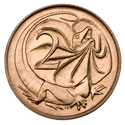
The Australian two-cent coin was introduced in 1966 and was the coin of the second-lowest denomination until it was withdrawn from circulation in 1992. It is still counted as legal tender, but is subject to some restrictions, and one-cent and two-cent coins are legal tender only up to the sum of 20 cents.

The Australian two-dollar note was introduced in 1966 due to decimalisation, to replace the £1 note which had similar green colouration. The note was issued from its introduction in 1966 until its replacement by the two dollar coin in 1988.
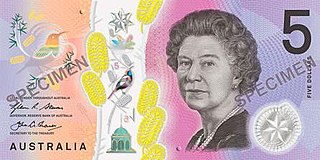
The Australian five-dollar note was first issued on 29 May 1967, fifteen months after the currency was changed from the Australian pound to the Australian dollar on 14 February 1966. It was a new denomination with mauve colouration – the pound system had no £2½ note.
Coins of the Australian dollar were introduced on 14 February 1966, although they did not at that time include one-dollar or two-dollar coins. The dollar was equivalent in value to 10 shillings in the former currency.
The Australian florin was a coin used in the Commonwealth of Australia before decimalisation in 1966. The denomination was first minted in 1910 to the same size and weight as the United Kingdom florin.
The banknotes of the Australian dollar were first issued by the Reserve Bank of Australia on 14 February 1966, when Australia changed to decimal currency and replaced the pound with the dollar. This currency was a lot easier for calculating cost rather than the British pound, shilling and pence system.
Coins of the Australian dollar are circulated with different designs depicting various anniversaries or significant Australian events, these differing coin designs being labelled Australian commemorative coins. Typically, only the 20c, 50c and $1 coins have been minted in commemoration, however in 2012 a commemorative $2 coin was minted for Remembrance Day and in 2016 a 25c gold coin was minted for Anzac Day.
